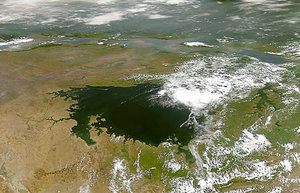Lake Victoria
|
|
Lake_Victoria_composite_satelite_photo.JPG
Lake Victoria or Victoria Nyanza is one of the Great Lakes of Africa.
Lake Victoria is 68,870 square kilometres in size, making it the continent's largest lake, the largest tropical lake in the world, and the second largest fresh water lake in the world in terms of surface area. Being relatively shallow, Lake Victoria ranks as the seventh largest freshwater lake by volume, containing 2,760 cubic kilometres of water. It is the source of the longest branch of the Nile River, the White Nile. The lake lies within an elevated plateau in the western part of Africa's Great Rift Valley and is subject to territorial administration by Tanzania, Uganda and Kenya.
There are more than 3,000 islands within Lake Victoria, many of which are inhabited. These include the Ssese Islands in Uganda, a large group of islands in the northwest of the Lake that are becoming a popular destination for tourists.
| Contents |
Exploration History
The first recorded information about Lake Victoria comes from Arab traders plying the inland routes in search of gold, ivory, slaves and other precious commodities. An excellent map known as the Al Adrisi map dated from the 1160s, clearly depicts an accurate representation of Lake Victoria, and attributes it as being the source of the Nile.
The lake was first sighted by Europeans in 1858 when the British explorer John Hanning Speke reached its southern shore whilst on his journey with Richard Francis Burton to seek the source of the Nile for strategic reasons of the British Colonial administration. Believing he had found the source of the Nile on seeing this vast expanse of open water for the first time, Speke named the lake after the then Queen of the United Kingdom. Burton, who had been recovering from illness at the time and resting further south on the shores of Lake Tanganyika, was outraged at Speke's audacity to claim this discovery for himself whilst on what was supposed to have been a scouting expedition. A very public quarrel ensued, which not only sparked a great deal of intense debate within the scientific community of the day, but much interest by other explorers keen to either confirm or refute Speke's discovery.
The well known British explorer and missionary David Livingstone failed in his attempt to verify Speke's discovery, instead pushing too far west and entering the Congo River system instead. It was ultimately the American explorer Henry Morton Stanley who confirmed the truth of Speke's discovery, circumnavigating the Lake and reporting the great outflow at Rippon Falls on the Lake's northern shore. It was on this journey that Stanley was said to have greeted the British explorer with the famous words Dr. Livingstone, I presume?, upon discovering the Englishman ill and despondent in his camp on the shores of Lake Tanganyika.
Ecology and Social Impacts
Lake Victoria plays a vital role in supporting the millions of people living around its shores, in one of the most densely populated regions on earth.
It is also an extremely sick ecosystem. During the 1950s, the nile perch (Lates niloticus) was introduced into the lake's ecosystem in an attempt to improve the yields of fishing in the lake. The nile perch proved totally devastating to the local ecosystem – of the hundreds of endemic species, many are now extinct. Further, the initial good returns on nile perch catches has diminished dramatically. Currently, the nile perch is being overfished. It is reported that some populations of endemic species have increased again.
An eco-problem with a happier outcome was the fight against the huge increase of Water Hyacinth (Eichhornia crassipes), a native of the tropical Americas, which forms thick mats of plant causing difficulties to transportation, fishing, hydroelectic power generation and drinking water supply. By 1995 90% of the Ugandan coastline was covered by the plant. With mechanical and chemical control of the problem seeming unlikely, the mottled water hyacinth weevil, (Neochetina eichhorniae) was bred and released into the lake with very good results.
Transportation
Since the 1900s Lake Victoria ferries have been an important means of transport between Uganda, Tanzania and Kenya. The main ports on the lake are Kisumu, Mwanza, Bukoba, Entebbe, Port Bell and Jinja.
See also
External links
- LakeNet (http://www.worldlakes.org/index.asp)
- Trouble in the Tropics (http://www.oneworld.org/patp/pap_victoria.html)
- Darwin's Nightmare (http://www.coop99.at/darwins-nightmare/index.htm), an award winning documentary film by Hubert Sauper on the global political economy of nile perch trade at lake Victoria and its social consequences for the region.ca:Llac Victòria
da:Victoriasøen de:Viktoriasee et:Victoria järv fr:Lac Victoria nl:Victoriameer ja:ヴィクトリア湖 pl:Jezioro Wiktorii ru:Виктория (озеро) sl:Viktorijino jezero sk:Jazero Ukerewe fi:Victoriajärvi zh:維多利亞湖

